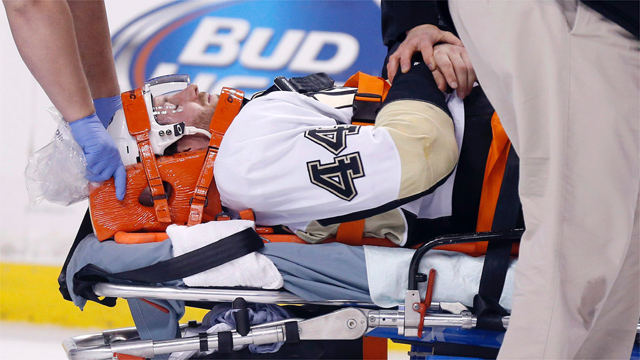TORONTO — Rock ’em-sock ’em hockey may give many fans a thrill, but researchers estimate that resulting player injuries cost the NHL more than $200 million a year — a hit to the league’s bottom line they suggest is likely recouped from the public’s wallets.
In a study published Monday, researchers at Toronto’s St. Michael’s Hospital estimate that NHL owners paid out at least US$653 million over three seasons to players who missed games due to injury.
The study found that more than 63 per cent of the 1,307 NHL players who laced up skates during the 2009-10, 2010-11 and 2011-12 regular seasons missed at least one game because of a hockey-related injury.
Within a single season, 51 per cent of all players were out with injuries for at least one game, representing a salary cost of US$218 million a year.
"There’s been a lot of resistance in the past from the NHL and hockey leagues to change rules because it’s sort of a given that if we take the violence out of the game, it’s going to mean less revenue," said neurosurgeon Dr. Michael Cusimano, the study’s principal researcher.
"So we wanted to understand, with the present state of affairs, what is the cost of these injuries? And we know from other research that many of these injuries, like concussion, are due to violent acts."
The NHL did not respond to multiple requests from The Canadian Press for comment on the study.
Using public databases that provide information on games played, player salaries and injuries, Cusimano’s team analyzed the types of injuries most often sustained, the numbers of games missed and the cost to the NHL in salary pay-outs.
During a 30-week sample, leg and foot injuries were found to be the most common reason for missing games. These lower-extremity injuries accounted for about 30 per cent of the total cost of unearned salaries, or roughly $68 million, the researchers report in the British Medical Journal’s publication Injury Prevention.
Head and neck injuries, such as concussions, were the second most likely to occur and resulted in an average of 11 missed games, the most of any injury. Head and neck trauma was also the most expensive in terms of lost salaries, at $353,300 per player hurt.
Time lost to concussions alone accounted for $42.8 million each year.
Over the three seasons, players sustained 323 concussions or suspected concussions, accounting for a total of $128.5 million in salaries for missed games. More than 10 per cent of those brain injuries or suspected brain injuries resulted in more than 30 missed regular season games.
"This research shows that preventable injuries — such as concussions, that are clearly related to violent acts in 88 per cent of cases — have an important economic burden in addition to the high personal health costs that players bear," Cusimano said.
Injuries to the groin were the third most common to occur, but were less costly on average ($203,900) than those to the shoulder ($306,600), arm/hand ($290,000) and chest/abdomen ($219,400), the study found.
"So it’s not inconsequential," Cusimano said of the price tag for injuries, adding that the figures do not include the cost of medical care.
Some of the money paid to injured players is covered by insurance. Cusimano said insurance companies start covering 80 per cent of salary for an injured player after he’s been forced off the ice for 30 games. Over the three seasons, the study calculated that insurance companies paid out roughly $21.6 million as a result of concussions alone.
"What does this mean to the fans?" said Cusimano. "It’s like any other business. If the price of gasoline goes up, you pay more at the pumps. If the teams have to recoup those costs, guess who’s going to be paying more?
"The fans."
Cusimano suggests the cost of injuries — and the effect on teams’ balance sheets — could be reflected in higher prices for game tickets and NHL-related merchandise.
"This is just another piece of evidence to say that things need to change," he said, repeating his call for rule changes that would more severely punish on-ice violence to prevent injuries like concussions.
"Employers are morally responsible for protecting their employees. The NHL owners need to do a better job of protecting their athletes — if not for their players, then for their own pocketbooks."









